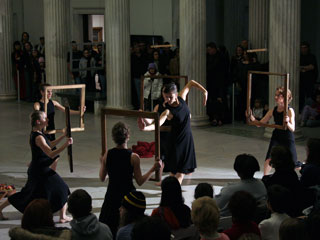Women in Black: Nimbus Dance at the Albright-Knox
by K. O'Day
The dramatic device of the classical Greek chorus marked the birth of tragedy (as Frederick Nietzsche argued in his book of the same name), and is considered by many scholars to be the very essence of the tragic experience. Wailing out its grief, whether in protest or in sympathy, the Chorus provides both a cue and an emotional outlet for the audience, either urging or censoring the characters of the drama with rhythmic dances, pantomimes and intonations. If indeed “All the World’s a Stage,” then the members of Nimbus Dance Company are more than players; they are commentators and tragic interpreters, using the many forms of media and artistic expression to speak to their audience.
The dance company’s latest performance, Windows 4: In Desperate Silence, was directed by husband/wife team Beth Elkins and Brad Wales, with Jennifer Golonka as co-director. Wales, who is an architect, designed the set in the classical stone sculpture court at the Albright-Knox Art Gallery, with help from Charlie O’Geen, Rich Maklary and UB’s Small Built Works Program. Custom-made steel compression rings provided cantilevered pipe supports for the six window frames hung in space, which each of the six dancers use as props. These were donated to the Albright-Knox after the show.
Performers include Beth Elkins, Jen Golonka, Kerry Ann Ring, Theresa Baker, Sherri Campagni and Amy Taravella (Campagni and Taravella are principal dancers at Neglia Ballet Artists and Buffalo Contemporary Dance, respectively). The choreography was shared between each member of the ensemble; collaborative choreography is a Nimbus trademark. The stunning musical accompaniment was composed and performed by David Kane and included extensive use of sampling, including gun shots, sirens and the whirr of helicopters.
The voice-over that plays throughout the performance is a soundtrack of readings handpicked to illustrate the very real modern tragedies that have been unfolding all over the world since the dawn of American civilization. Fittingly, the first reading is an excerpt from Howard Zinn’s “A People’s History of the United States”—an unflinching look at Columbus’ “discovery” of the Americas and the consequent subjugation and ultimate annihilation of the Indian tribes he found living there. Read by Kristi Meal, this piece sets the tone for the entire performance as the horrors inflicted by the European explorers are detailed: “Our work was to exasperate, ravage, kill, mangle and destroy” wrote historian Bartolome de las Casas, who transcribed Columbus’ journals. “In a short time this land which was so great, so powerful and fertile... was depopulated... My eyes have seen these acts so foreign to human nature, and now I tremble as I write...”
Twelve devastating pieces follow this one, each a true tale of first-person accounts of injustice and brutality (with the exception of a reading of Dr. Seuss’ “The Lorax,” which comes as a welcome relief— at least until the plight of the Truffala Trees is considered) set to dramatic, emotive choreography. From Appalachia to Viet Nam, these scenarios are detailed by some of modern history’s greatest thinkers and activists: Noam Chomsky, Leyla Zana, Robert F. Kennedy, ,Jr., Kerry Kennedy and Wangari Maathai, Rachel Carson and Leonard Peltier, to name a few. Perhaps the most disturbing is a reading done by Ms. Elkins, taken from William Langeweische’s “Rules of Engagement” for Vanity Fair. It details the massacre of an entire Iraqi family by American Marines, in the words of the lone survivor, a 13 year-old girl:

Daddy was shot in the head and chest. He was 43
Mommy was shot in the head and chest. She was 41.
Aunt Huda was shot in the chest. She was 27.
My sister Nour was shot in the right side of her head. She was 15.
My sister Saba was shot through the ear. She was 11.
My brother Muhammed was shot in the hand and I don’t know where else. He was 10
My sister Zainab was shot in the hand and head. She was five.
My sister Aysha was shot in the head and I don’t know where else. She was three.
It’s difficult to describe the effect of these words, but the dancers express it through powerful, understated movements that give a kind of voice to the audience, as though mirroring the spectators’ reactions. It is this quality that is reminiscent of the ancient tragic chorus, and that suggests the deeper intent of Nimbus Dance Company. As founder Beth Elkins wrote in the program for Windows 4, “For this performance, I decided to give voice to issues and individuals who have been silenced.” She also gives a voice to her audience by connecting us to the larger drama at play: In this case that drama is our country, our humanity, our world.
|
Issue Navigation> Issue Index > v6n6: Love Stories (2/8/07) > Women in Black: Nimbus Dance at the Albright-Knox This Week's Issue • Artvoice Daily • Artvoice TV • Events Calendar • Classifieds |









 Current Issue
Current Issue